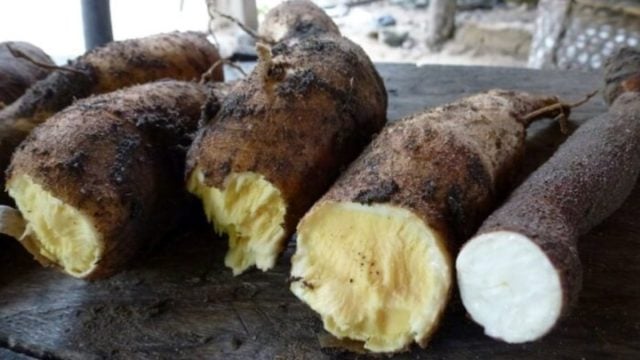Curiosity led a Venezuelan to become interested in a fetid and poisonous liquid that emerged from the pressing of cassava, a tuber native to South America, used to make an ancestral food. After experimenting in his laboratory, he verified that from this substance, which is usually discarded, he could obtain biofuel.
José Gregorio Jiménez is a folk inventor who was born in the state of Carabobo (central north), where one of the main Venezuelan industrial parks is located and a good part of the agricultural production is concentrated. He graduated as a university technician in Electronic Technology, explains the journalist Nathali Gómez in a report for RT.
His proposal to generate non-fossil fuel with the waste of cassava has given him several recognitions and satisfactions, despite the fact that its application, with costs that could be 70% lower than those of gasoline production, has not been extensive in the country.
However, he is confident that his project may get a new boost from the authorities, given the complex panorama of sanctions, which make it difficult to import technology into Venezuela and the entry of components to produce gasoline.
First the cassava
To understand how cassava-based ethanol is produced, it is necessary to first talk about the preparation of an ancestral South American food that is made with this tuber. This is cassava or ‘casabe’, a crunchy, flat, unleavened cake made from a variety of bitter yucca.
In Venezuela, it is the food base of several native peoples, both in the north and south, but in general, it is consumed by a good part of the country. Its manufacture can be handmade or industrial.
Initially, to obtain the ‘casabe’, the tuber must be grated and pressed. After this process, the cassava loses between 60 and 80% of its volume and releases a milky, bitter, starchy substance with a foul odor.
The liquid that emerges, called ‘yare’, is poisonous, because it has a high cyanide content. As it cannot be used, it is discarded and dumped into a septic tank, where methanol, a greenhouse gas, is produced.
From poison to ethanol
For the ‘yare’ to be transformed into ethanol, a process of filtration is carried out, followed by pasteurization, to eliminate the bacteria that are naturally found in the liquid. Subsequently, an enzymatic process or enzymatic hydrolysis is carried out, «which is the industrial secret» or the technology that Jiménez discovered.
After enzymatic hydrolysis comes hydrolyzation, which corresponds to the subdivision of the molecules of the substance. Then, the starches present in the ‘yare’ are transformed into primary sugars such as glucose and sucrose.
«These two types of sugars react or ferment with yeasts, the ones used for beer or for bread, and cause them to transform into alcohol and carbon dioxide», says the folk inventor.
An unexpected discovery of the Venezuelan
Jiménez clarifies that he is not a chemist and that he had to learn what was necessary to be able to carry out his project. Like so many other inventions in history, the discovery of ‘Yaretanol’ was accidental.
He remembers that in 2006, during a visit to the Campo de Carabobo area (A site where the historic battle of Carabobo occurred), in his home state, he arrived with a friend to the sector known as El Rincón, where ‘casabe’ has been made for more than a hundred years. In that place, he was able to see the complete process of how it was produced by hand.
Seeing and hearing about the ‘yare’ he asked for a sample. From there, he began his research, which has been going on for about fourteen years.
Ethanol without corn
Jiménez’s proposal to produce biofuel has a fundamental difference with the production of ethanol based on corn. The bitter cassava variety is not edible and is an agro-industrial waste, while the cereal is one of the most important foods in the world.
But not only the tuber from which the ‘casabe’ originates from is a candidate for the generation of ethanol. The researcher has done many tests «because the idea is not to do it with the food but with its waste».
As an example of fuel inputs of plant origin, he speaks of small potatoes, which are discarded by farmers because they do not have the required size or quality; carrots, beets, and any by-products that have sugar or starches.
In addition, he is experimenting with algae, both freshwater and saltwater, to produce food and biodiesel.
Why doesn’t the project achieve a large scale application?
Jiménez states that his project has a stage of development, start-up and consolidation. Although he has already been working on it for more than ten years, he has not achieved its large-scale application.
«We come from a country that depends on oil, so creating a similar component that replaces gasoline is a competition against a State company that dominates many areas», he says.
Another issue that makes it difficult to crystallize is the budget, since the cost of an ethanol production plant that supplies the country cannot be financed by one person. “This is a State project and I am willing to sit down with President Maduro so that we can apply it here”.
The Venezuelan technologist asserts that years ago the current needs did not exist and that this is a good opportunity to develop it. «It is not a personal project, the idea is that it be applied here, with the participation of allied countries, because it requires a significant investment to generate a renewable source of biofuels and food», he adds.
How much would Venezuela save with this proposal?
Faced with an economy crisscrossed by sanctions and the blocking of Venezuelan State accounts abroad, which makes it difficult to purchase machinery and spare parts, Jiménez explains that the advantage of his proposal is that it has been fully developed in the South American country. This includes enzymes, equipment, distillation plants, among others. «Everything has been perfected without needing any type of import», maintains Jiménez.
Ethanol costs 70% less to produce than gasoline and can be used as a fuel additive on a scale from 10% to 50%.
In addition to the generation of fuel, the flour used in the ‘casabero’ sector would be produced, which is used for human and animal consumption.
“It is a 100% friendly product with the environment, which generates a 50% drop in carbon monoxide emissions and an improvement in vehicle performance, because it raises the octane rating”, he says.
He affirms that in addition to reducing carbon dioxide emissions, this greenhouse gas could be captured by planting multiple hectares of cassava and other products to generate ethanol.
«It is a practically inexhaustible product because it is 100% renewable and Venezuela has a fairly large territory, where 75% of the country can be used to plant cassava and other crops».
Acknowledgments to the inventiveness of this Venezuelan
Jiménez has received recognition both inside and outside the South American country. The first obtained in Venezuela was the Prize of the Institute of Advanced Studies (IDEA), in 2008. A year later he was awarded the Luis Zambrano National Prize for Popular Technological Invention.
The project of this Venezuelan has also been distinguished in cities such as Bogotá (2009); Amsterdam (2010), where he came in third place at the World Biofuel Congress and in Dubai (2011), where he was awarded the Good Practices to Improve Living Conditions award, in 2011.











